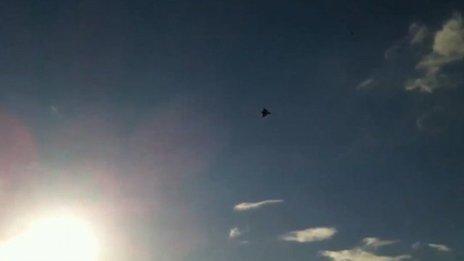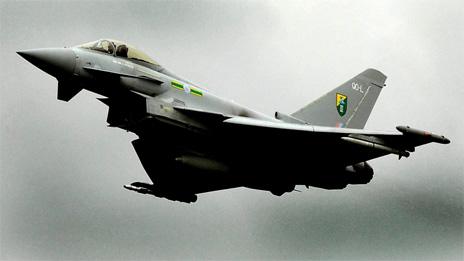'Helicopter hijack code' triggered sonic boom Typhoons
- Published
Bath resident Ric McLaughlin captured a sonic boom in 2012 when a Typhoon jet was responding to an emergency call
A data entry error by a helicopter pilot led to two Typhoon aircraft being scrambled in an emergency response.
A loud bang was heard across parts of England at about 18:10 BST on Thursday.
The MoD revealed it was a boom from a Typhoon authorised to go at supersonic speed while responding to an emergency call from a helicopter.
It confirmed that the helicopter pilot had transmitted the wrong signal by mistake. A flight instructor said the signal may have suggested a hijacking.
Emergency services in the West Midlands and south-west England received numerous calls about the sonic boom.
The helicopter was flying over the Cotswolds near Bath when it was intercepted.
MoD spokesman Martin Tinworth said: "There's a thing on each aircraft called a transponder.
"You select numbers on it and that transmits to the ground air traffic controllers who you are and where you are.
"It's just like a thunderclap" - Dr Jim Wild on how and why a sonic boom happens
"If you mis-select a certain series of numbers, you can send the wrong signal out.
"If someone starts transmitting an emergency signal by mistake or intentionally, it will be picked up by air traffic controllers.
"That would be passed to national authorities... assessed, and if they can't get in touch with the guy quick enough - which happened in this case - a Quick Reaction Alert will be launched."
Mr Tinworth said there were four Typhoons on alert, 24 hours a day, 365 days a year, based at RAF Coningsby in Lincolnshire.
"The only time anyone hears about it is when it's over land and when there's noise made - which happened yesterday.
"Pilots need authorisation to go supersonic because it makes noise and upsets people," he said.
Hijack number
This sequence of events was backed up by a helicopter instructor, who did not wish to be named.
He said: "The transponder is a box on the dashboard and it just identifies which green blip you are on the screen for air traffic control.
"The number that you put in the transponder if you're just flying around is 7000.
"But if you've been hijacked, you put in 7500.
"So it's possible he might have entered the hijack code instead - and in the current climate, that well might trigger Typhoons.
"And maybe people are getting twitchy with the Olympics around the corner.
"I have to admit, I did raise an eyebrow when I saw the news. It is certainly unusual for Typhoons to be scrambled."
The identity of the helicopter pilot is still unknown.
"Where he was flying to and what he was doing is none of our business," said Mr Tinworth.
"People are allowed to fly in the UK because we're a free country."
It is the second time this year that a sonic boom has been created by a Typhoon aircraft.
In January, the MoD confirmed that a loud noise heard by people across the north of England was caused by an RAF fighter jet breaking the sound barrier.
- Published13 April 2012

- Published12 April 2012
